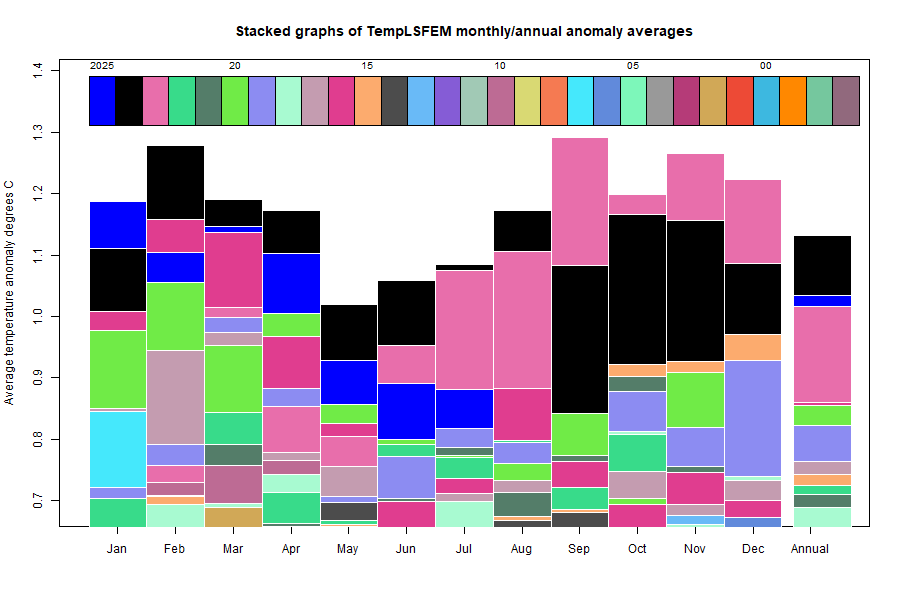Here is the corresponding stacked graph, showing how much hotter recent months have been:

Here is the temperature map, using the FEM-based map of anomalies. Use the arrows to see different 2D projections.
As always, the 3D globe map gives better detail. There are more graphs and a station map in the ongoing report which is updated daily.
This post is part of a series that has now run since 2011. The TempLS mesh data is reported here, and the recent history of monthly readings is here. Unadjusted GHCN is normally used, but if you click the TempLS button there, it will show data with adjusted, and also with different integration methods. There is an interactive graph using 1981-2010 base period here which you can use to show different periods, or compare with other indices. There is a general guide to TempLS here.
The reporting cycle starts with the TempLS report, usually about the 8th of the month. Then when the GISS result comes out, usually about the 15th, I discuss it and compare with TempLS. The TempLS graph uses the FEM solution on a regular near equal area grid on the sphere ; the residuals are displayed more directly using a triangular grid in a WebGL plot here.
A list of earlier monthly reports of each series in date order is here:
Does this mean that July 2024 is the hottest July on record? Or is it still July 2023? if so, the world is in a bad way.
ReplyDeleteAccording to TempLS - This is 14 record months in a row - that's right. Duh, there are several popular models, each of them very accurate and not much different from each other, but here all models are unlikely to draw the same conclusions.
DeleteAs I said, it was, by a whisker over 2023. That could be reversed by late data, although late data usually increases T, if anything. Yes, when it is this close, other indices, when they come out, may not have July warmest.
DeleteHey Nick, I do not seem to have an email for you. I would be happy to include TempLS in some 2024 vs. 2023 comparisons I'm doing across surface instrumental and reanalysis products. Do you have a way to export TempLS as netcdf or some other spatial format? My email is peter dot jacobs at nasa dot gov. Please send me a note if you're interested! Thanks!
ReplyDeleteHi Peter,
DeleteThanks. I'm writing an email.
It looks like the August data have been added to the stacked graph - is that an automatic update? An error? (it seems early in the month..) If it's as it seems it is yet another quite surprisingly warm month.
ReplyDeleteYes, it is an automatic update. I have just one web graph which I point to in every month's post, so the updates show. And yes, it is early in the month. I do calculate a global average as soon as the ocean data comes in, as it now has. However, I don't post officially until there are 3200 land stations outside the US reporting; currently there are 3015. So the graph is showing well-based data, but it might change a little in the next day or two.
DeleteAnd yes, I think it is a surprisingly warm month. Satellites showed it as warmest ever - discussed here:
https://www.drroyspencer.com/2024/09/uah-global-temperature-update-for-august-2024-0-88-deg-c/